In this blog, you’ll read about…
🌑 The deeper symbolism behind Ma Kali’s form, weapons, and cosmic power
🏯 The sacred stories of India’s most revered Kali temples
🕉️ The lives of mystics who communed directly with Ma Kali
🔺 The role of the Kali Yantra and how it unlocks the path of Tantra
☠️ The secretive practice of Shav Sadhana
📱 How the Tantra Sadhana App makes Ma Kali’s esoteric worship accessible today
The Divine Vision of Ma Kali at Dakshineshwar Kali Temple
In the sacred precincts of the Dakshineshwar Kali Temple, where the Ganges glides past ancient stones and devotional songs echo through marble corridors, one of the most profound love stories in spiritual history unfolded — the story of Ma Kali and Her devotee, Sri Ramakrishna.
Here, amidst incense and chants, the young Gadadhar Chattopadhyay, later known as Sri Ramakrishna, served as the priest of the shrine dedicated to Kali Mata. Yet, unlike other priests who performed rituals mechanically, his heart burned with a question that consumed his every waking moment:
“Is the Mother Kali merely a stone statue, or is She a living, responding presence?”
This longing was not born of curiosity, but of deep yearning for Divine Union. Day after day, he stood before the radiant image of Ma Kali, singing the soul-stirring songs of Ramprasad Sen and Kamalakanta Bhattacharya, pouring out his heart in prayer:
“Mother, You revealed Yourself to Ramprasad — why won’t You show Yourself to me? I don’t want wealth, friends, or worldly pleasure. Just reveal Yourself to me!”
One evening, his anguish reached its breaking point. Overwhelmed by despair, he rushed to the sanctum and seized the ceremonial sword, crying,
“Mother, if You will not show Yourself to me, I have no desire to live!”
At that very instant — when human effort had reached its limit — divine grace descended. The temple was suddenly filled with a dazzling light. The walls, floor, and ceiling pulsed with consciousness itself.
And before him appeared the living form of Ma Kali — luminous, compassionate, and alive.
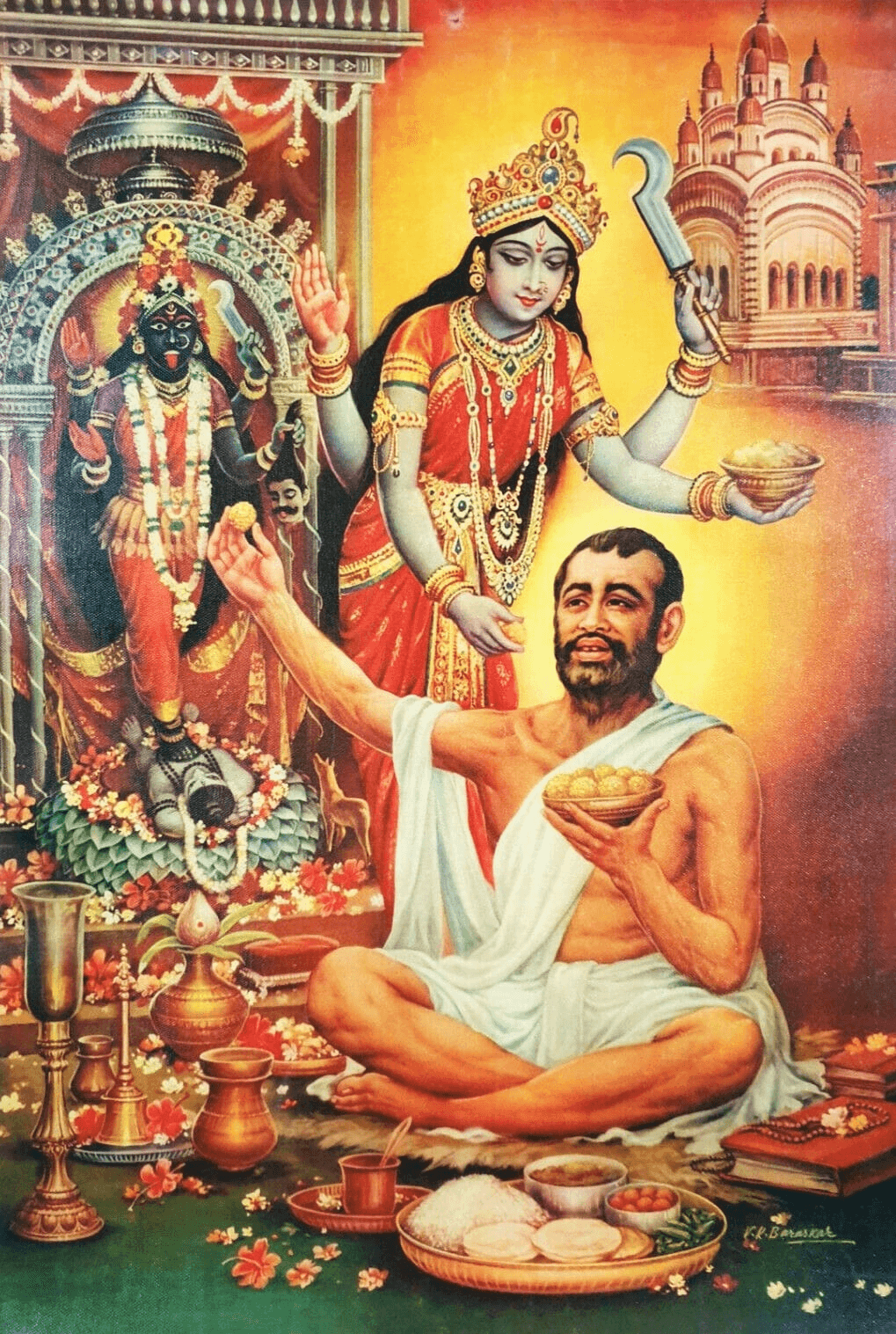
She was not fierce or fearsome, but infinitely tender — smiling, radiant, and full of maternal love. Her presence was more tangible than any material form.
Sri Ramakrishna felt Her breath, Her warmth, and the heartbeat of eternity itself.
The vision was so overwhelming that he lost all external awareness, merging into waves of divine bliss. Later, he described it as dissolving into an ocean of pure love, where “the self vanished, and only the Divine Mother remained.”
When he awoke, life itself had transformed. The stone image had become the living Ma Kali, and their relationship grew into an intimacy beyond comprehension.
From that day, Ramakrishna no longer saw Her as an idol — only as the embodied Mother of the Universe.
He would often sing this verse by Ramprasad Sen, describing the inner virtues one must cultivate to behold the Divine Mother:
Come let us go for a walk, O mind, to Kali the Wish-fulfilling Tree,
And there beneath it gather the four fruits of life.Of your two wives, Dispassion and worldliness,
Bring along Dispassion only on your way to the Tree,
And ask her son Discrimination about the truth.When will you learn to lie, O mind, in the abode of blessedness,
With cleanliness and defilement on either side of you?Only when you have found the way
To keep these wives contentedly under a single roof,
Will you behold the matchless form of Ma Kali.
The Origin Stories of Ma Kali
Ma Kali is one of Hinduism’s most powerful and complex manifestations of the Divine Feminine, embodying both the fierce destroyer of ignorance and the tender, loving Mother who guides Her children toward liberation.
As the first among the ten Mahavidyas (Great Wisdom Goddesses), She represents the primordial force that existed before time itself, wielding the power to both create and destroy with equal compassion.
Her presence is central to Tantra Sadhana, where She is revered not only as a cosmic force, but as a personal deity who grants liberation to those who surrender to Her with full devotion.
Her origins trace back to the very dawn of cosmic consciousness — emerging from what Hindu cosmology describes as the primordial void before creation.
The earliest mention of Ma Kali appears in the Atharva Veda, where She is described as one of the seven tongues of Agni, the fire god, representing the consuming aspect of divine energy.
But Her evolution into the fierce and loving Goddess we know today unfolded gradually over centuries of spiritual and scriptural development.
The most widely known story of Kali appears in the Devi Mahatmyam, a sacred text that remains central to both Tantra Sadhana and devotional Bhakti traditions.
In this tale, the cosmos is under threat from the demons Madhu and Kaitabha, embodiments of chaos and ignorance. To destroy them, Ma Durga’s divine fury manifests as Ma Kali — bursting forth from Her third eye in a blaze of unstoppable energy.
She emerges fully formed: naked, wild-haired, and radiant with Shakti, wielding weapons in Her many arms. Her terrifying form is not evil, but the ultimate purifier — destroying ego, illusion, and darkness in all forms.
Ma Kali is thus not simply a Goddess of war or rage — She is the uncontainable energy of truth, the dark womb that births both dissolution and transcendence.
It is this paradox that makes Her beloved in Tantra, feared by some, and adored by those who have glimpsed the freedom that lies beyond fear.
Other Origin Stories from Sacred Texts
In another profound origin narrative found in the Linga Purana, Ma Kali manifests when Ma Parvati enters Lord Shiva's throat, merging with the cosmic poison, Halahala, that He had consumed during the churning of the ocean.
This union transforms Her into the dark Goddess Kali, who then emerges to vanquish the demon Daruka — a being who could only be killed by a female deity.
This story symbolically represents the transformation of Divine Feminine energy through the absorption of cosmic toxicity, emerging stronger and more powerful.
The Vamana Purana presents yet another fascinating origin story. In it, Kali emerges when Lord Shiva calls Ma Parvati “Kali” (meaning “the black one”) in jest.
Offended by this reference to Her dark complexion, Ma Parvati separates Herself into two beings — the fair Gauri and the dark Kali — demonstrating how Divine Consciousness can manifest in multiple forms simultaneously.
This narrative emphasizes that Kali’s darkness is not something negative, but represents the infinite void from which all creation emerges, and into which it eventually dissolves.
The Symbology of Ma Kali
Ma Kali’s iconography is among the most complex and symbolically rich in all of Hindu theology. Every element of Her appearance carries profound spiritual significance.
Her dark — often described as bluish-black — complexion represents the infinite void of Brahman, the ultimate reality beyond all qualities and forms. This darkness is not symbolic of evil, but of timelessness (Kala) — the eternal presence that remains unchanged through all cycles of creation, preservation, and destruction.
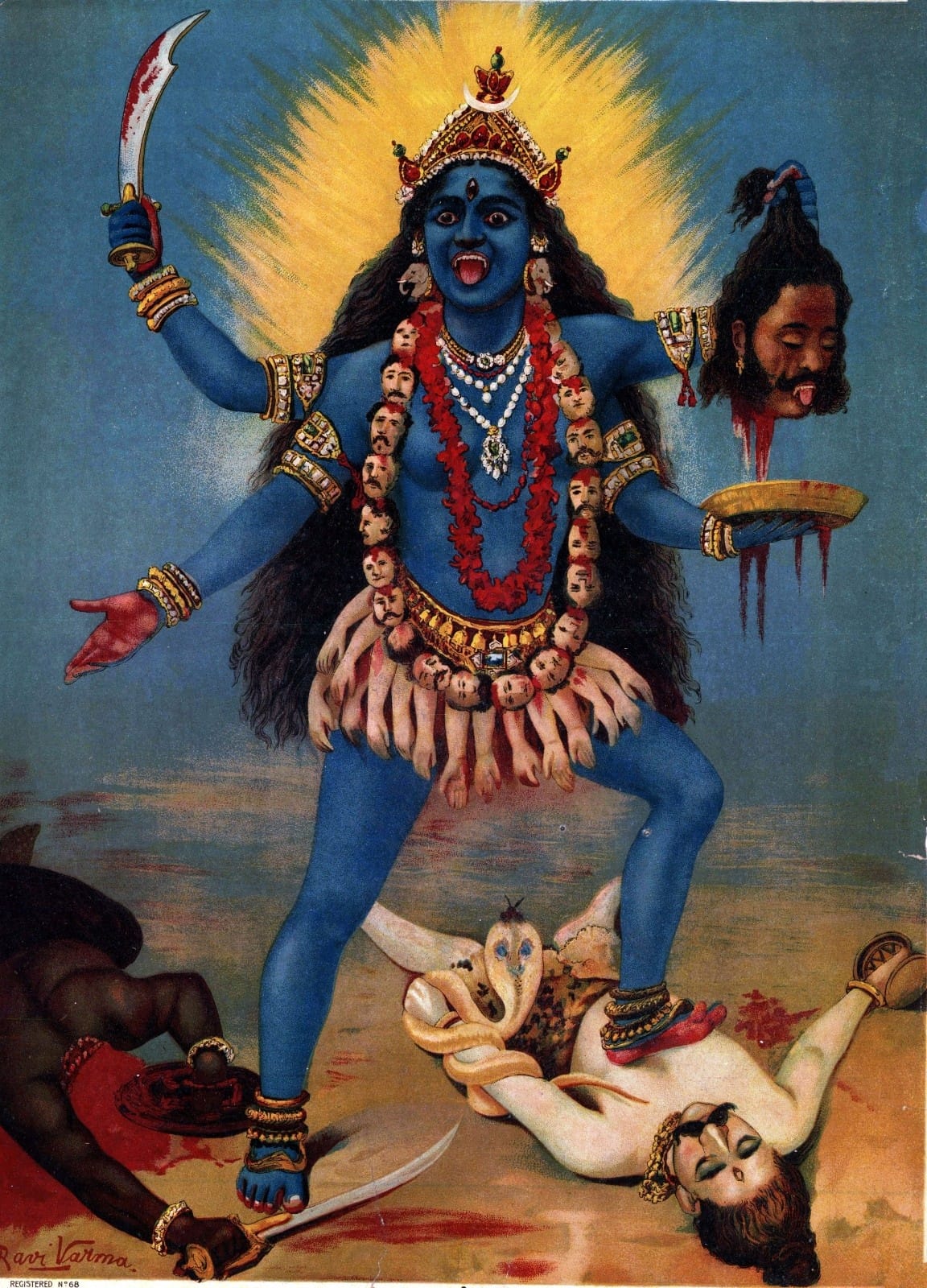
Her wild, unbound hair flowing freely signifies the liberated energy of Shakti, untamed by social conventions or material limitations. It reflects a consciousness that is unconditioned — a state of spiritual freedom that transcends worldly attachments.
The three eyes on Her forehead represent omniscient vision — across past, present, and future.
Her third eye, in particular, is the eye of intuition and spiritual wisdom, granting insight that goes beyond ordinary perception.
The Sacred Weapons and Their Spiritual Significance
Ma Kali’s four arms typically hold symbolic objects, each representing a unique aspect of spiritual liberation.
The curved sword (Khadga) in Her left hand signifies the sharp blade of divine knowledge, which severs the bonds of ignorance and ego attachment.
The severed demon head symbolizes the destruction of the ego-mind — the false self that must be dissolved for true spiritual awakening.
Her right hands are usually shown in Mudras:
- Abhaya Mudra (gesture of fearlessness)
- Varada Mudra (gesture of boon-giving)
These reveal Her dual nature — fierce in battle, yet infinitely compassionate to sincere devotees.
Her naked form represents truth in its purest, unveiled state — the raw essence of reality, untouched by illusion or social conditioning. It is a symbol of liberation, where nothing remains hidden.
The garland of fifty-one severed heads around Her neck represents the fifty-one letters of the Sanskrit alphabet, establishing Her as the primordial source of sound, speech, and sacred knowledge.
The skirt of severed arms signifies the accumulated karma of Her devotees — which She removes and transforms, liberating them from the weight of past actions.
The Sacred Union with Lord Shiva
One of the most iconic aspects of Ma Kali’s imagery is Her standing or dancing upon the prone body of Lord Shiva, Her Divine Consort.
This powerful visual carries deep symbolic meaning:
- Lord Shiva represents pure consciousness (Purusha) — still, eternal, and unchanging.
- Ma Kali embodies dynamic creative energy (Prakriti) — active, expressive, and transformative.
Her foot upon His chest represents the activation of cosmic consciousness by the Divine Feminine. Without Shakti, Shiva remains inert; without Shiva, Shakti has no form.
Another interpretation comes from a sacred moment in Her mythology:
When Ma Kali’s destructive dance threatened to annihilate the universe, Lord Shiva lay down in Her path to absorb Her fury and restore cosmic balance.
In most depictions, Her tongue protrudes — not out of bloodlust, but in shock and humility upon realizing She has stepped on Her beloved.
This symbolizes how even the most fearsome divine energy is tempered by love, awareness, and devotion.
Kali Yantra: Sacred Geometry of Divine Consciousness
The Kali Yantra is one of the most refined applications of sacred geometry in the Tantric tradition. It serves both as a meditation tool and a symbolic map of cosmic consciousness.
Unlike artistic depictions of the Goddess, Yantras are geometric diagrams that channel the subtle energy patterns of a Deity. They are used in Tantra Sadhana to invoke, meditate on, and merge with specific aspects of Divine Energy.

At the heart of the Kali Yantra lies the Bindu — the central point symbolizing the source of all existence. Surrounding it are concentric circles, lotus petals, and triangles, each representing a different layer of the cosmos and stages of spiritual awakening.
Downward-facing triangles represent the Divine Feminine (Shakti). Meditating on the Kali Yantra involves step-by-step inward focus — beginning from the outer elements and gradually moving toward the Bindu.
This structured approach gently dissolves the illusion of separateness, aligning the practitioner with the vibration of the Goddess Herself — vast, fearless, and transcendent.
The Divine Saints Who Worshipped Ma Kali
The spiritual legacy of Ma Kali shines most brilliantly through the lives of the saints who did not just worship Her — they lived with Her.
Across centuries, extraordinary seekers — poets, householders, mystics, and reformers — have walked Her path. Their devotion transcended ritual and transformed into living, breathing relationships with the Divine Mother.
These saints sought not just blessings, but direct communion with Ma Kali, surrendering themselves with childlike trust and fearless love.
- Ramakrishna Paramahamsa, the mystic saint of Dakshineshwar, would enter divine trances in Her presence, treating Her as his playful, all-loving Mother.
- Ramprasad Sen and Kamalakanta Bhattacharya, the great poets of Bengal, sang to Her with raw emotion, longing, and ecstatic surrender — their songs still echo through Kali temples today.
- Krishnananda Agamavagisha, the Tantric scholar and practitioner, delved into Her mysteries through deep Sadhana, revealing the secret pathways to Her grace.
- Bamakhepa, the “mad saint of Tarapith,” offered Her his wild devotion, untouched by societal norms, surrendering his very identity into Her fire.
Each of these saints walked a unique path — some through Bhakti, others through Tantra Sadhana — yet all were lifted by the same fierce love that Ma Kali bestows upon those who dare to surrender.
Their lives remind us: Ma Kali is not distant or abstract. She is close, personal, real — and ever-ready to guide the sincere seeker beyond fear, ego, and worldly bondage into divine freedom.
Sri Ramakrishna Paramahamsa: The Perfect Devotee
Sri Ramakrishna Paramahamsa embodies the pinnacle of Ma Kali worship, illustrating how complete surrender to the Divine Mother can transform an ordinary human into a living embodiment of divine consciousness.

Image Credits: oldindianphotos.in
Born as Gadadhar Chattopadhyay in the village of Kamarpukur, Bengal, his life became inseparably intertwined with Ma Kali from his early twenties, when he began serving as a priest at Dakshineshwar Temple.
His approach to Kali Sadhana revolutionized traditional religious practice. He showed that the Divine Mother is not merely a philosophical idea, but a living, responding Presence — fully accessible to sincere devotees.
Unlike conventional priests who maintained formality, Ramakrishna treated Ma Kali as his actual mother, speaking to Her, arguing with Her, and sharing moments of deep intimacy. These interactions shocked many orthodox observers — but also produced extraordinary spiritual results.
His devotion expressed itself in remarkable ways:
- He would refuse to eat unless Ma Kali accepted his offering first.
- Many witnessed the temple image consume food from his hands.
- During worship, he entered deep Samadhi, losing all awareness of the external world. Others had to care for his physical needs during these states of divine absorption.
Ramakrishna also undertook rigorous Tantra Sadhanas under several teachers and explored multiple paths to the Divine — including Hindu, Islamic, and Christian traditions. In each, he received direct divine visions, yet his relationship with Ma Kali remained his spiritual home.
His teachings, recorded in The Gospel of Sri Ramakrishna, continue to guide and uplift millions of spiritual seekers around the world.
Perhaps the most profound aspect of his life was how he attained the highest divine realization while remaining rooted in human relationships. His marriage to Sarada Devi, who lived at Dakshineshwar and is considered an incarnation of the Divine Mother Herself, was a union of spiritual depth, not worldly attachment.
Through his life, Sri Ramakrishna showed that the Divine and the worldly can co-exist — when approached with purity, surrender, and the unshakable love of Ma Kali.
Ramprasad Sen: The Poet-Saint of Divine Longing
Ramprasad Sen transformed Bengali spiritual literature through his extraordinarily intimate devotional songs to Ma Kali, creating a new form of religious expression that continues to inspire devotees three centuries later.
Born in Halisahar village, approximately 35 miles north of Kolkata, into a Tantric Baidya-Brahmin family, Ramprasad showed exceptional poetic talent and a deep spiritual inclination from early childhood.
His formal introduction to Kali Sadhana came during his initiation ceremony at the age of 22, when his Guru, Madhavacharya, whispered the sacred Mantra into his ear. In that moment, Ramprasad experienced such intense longing for the Goddess that his entire life changed permanently.
He later became a disciple of Krishnananda Agamavagisha, the renowned Tantric master who introduced Kali Puja to Bengal.
A Life Given to Devotion and Poetry
The most famous story of Ramprasad's spiritual calling took place during his employment as an accountant in Kolkata. Despite his financial hardship, he spent his workdays writing poems to Ma Kali in his ledger books instead of maintaining financial accounts.
Rather than being punished, his employer was so moved by the poetry that he granted Ramprasad a monthly stipend of thirty rupees, asking him to return home and dedicate himself to spiritual practice and composition.
Back in his village, Ramprasad began a remarkable practice: standing neck-deep in the Ganges River, singing to Ma Kali with such divine fervor that boats would stop to listen and dying people requested his presence at their final moments.
His Sadhana also included meditating for hours in a Panchavati grove, on a Panchamundi Asana (an altar made of five skulls), a rare and powerful Tantric practice. Through this path, he received direct visions of Ma Kali in Her form as Adyashakti Mahamaya.
Recognition by Royalty, Revered by the Masses
Raja Krishnachandra of Nadia, a devout worshipper of Ma Kali, heard Ramprasad's songs and appointed him as court poet. However, Ramprasad rarely appeared in court, choosing instead to immerse himself in Sadhana. In gratitude, the Raja gifted him 100 acres of tax-free land and bestowed the title “Kaviranjana” (Entertainer of Poets).
Ramprasad composed over 100,000 devotional songs. Some of his most influential collections include:
- Vidyasundar
- Kali-Kirtana
- Shaktigiti
His style was revolutionary — addressing Ma Kali not with distant reverence, but with raw, emotional intimacy: sometimes as a loving Mother, sometimes as a mischievous Daughter, and often as a stern or absent Parent.
These songs created a new devotional vocabulary that still echoes in Bengali spirituality today.
Final Liberation Through Devotion
Ramprasad’s spiritual culmination occurred during Kali Puja around the year 1775. After an all-night worship filled with singing and prayer, he carried the sanctified water jar to the Ganges for the final ritual.
As the clay image of Ma Kali dissolved into the holy river, Ramprasad waded deeper into the water, singing to Her. At the exact moment of immersion, he merged with the Ganges, leaving his physical body behind — a final act of surrender in union with the Divine Mother.
Bamakhepa (1837–1911): The Mad Saint of Tarapith
Bamacharan Chattopadhyay, known to the world as Bamakhepa (the Mad Saint), stands as one of the most unconventional yet profound examples of divine communion in the Tantric tradition.
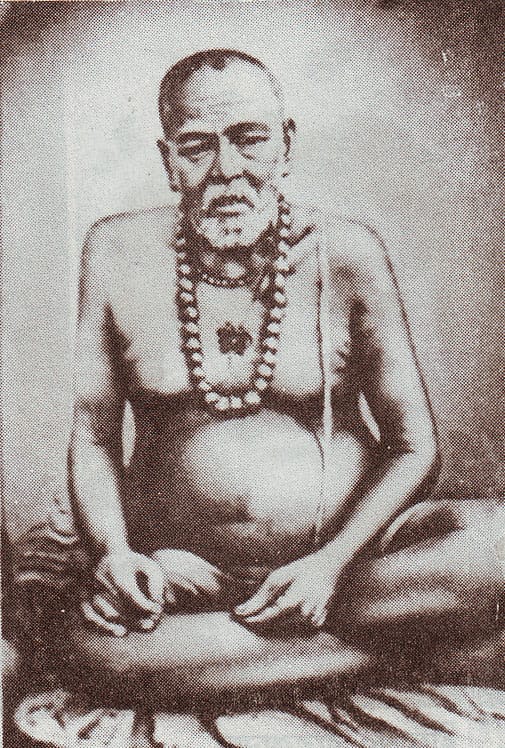
Born in Atla village near Tarapith in Birbhum district, his spiritual intensity became evident from early childhood—expressing through behaviors that society could not comprehend, but which unmistakably marked him as an extraordinary soul.
As a young boy, Bamakhepa developed a peculiar habit that revealed his deep spiritual inclination: in the dead of night, he would sneak into neighbors' homes, steal their family deity images, and carry them to a distant riverbank where he would worship them through the night.
Despite scoldings and attempts to stop him, he repeated this nightly ritual, driven by an irrepressible need for Divine communion.
Early Life and Spiritual Calling
Bamakhepa lost his father at a young age, leaving his spiritual education to his mother and widowed elder sister, who nourished him with ancient stories and basic Sadhanas.
Despite extreme poverty and limited formal schooling, he showed no interest in worldly life, earning the nickname Khepa ("mad"). In Tantric vocabulary, however, this madness refers not to mental instability but to Divine intoxication.
He eventually left home and came under the guidance of Swami Makshadananda in Dakshingram, later moving to Maluti, an ancient temple village on the banks of the Dwarka River.
His most significant transformation came under the tutelage of Baba Kailashpati, who initiated him into advanced Tantric and Yogic practices. With time, Bamakhepa rose to become the spiritual head of Tarapith.
Sacred Madness and Divine Recognition
Bamakhepa's behavior regularly clashed with orthodox temple norms.
He would often eat food offerings meant for the Deity, violating ritual protocol. On one occasion, temple priests physically assaulted him for this. But soon after, Ma Tara appeared in a dream to Rani Bhabani, the Queen of Natore, instructing her to feed the saint first, as he was Her beloved son.
From then on, the temple priests began serving Bamakhepa before the Deity Herself, acknowledging his elevated spiritual status. His Divine connection had been confirmed—not by men, but by the Goddess Herself.
Sadhana Among the Flames
Bamakhepa spent most of his spiritual life in the cremation ground beside the Tarapith temple.
This terrifying realm of ashes, bones, and burning pyres became his spiritual laboratory, where he performed intense Tantric Sadhanas.
These extreme practices culminated in a direct Darshan of Ma Tara in Her ferocious form. She then held him to Her breast, symbolizing the full merger of devotee and Deity—the sacred moment of spiritual completion.
The Mad Saint’s Teachings and Legacy
Bamakhepa's teachings were as unconventional as his life.
He taught through paradox, humor, silence, and erratic gestures, which revealed deep spiritual truths to those with open hearts. His wisdom could not be decoded through logic alone; it was a path for the faithful and the fearless.
Devotees came from across India—seeking blessings, healing, or simply his presence. Some left cured. Others left transformed.
Bamakhepa’s life reminds us that Divine realization doesn’t always wear the robes of respectability. Sometimes, it roars like madness, sleeps in cremation grounds, breaks rituals, and dances beyond reason.
He is a living embodiment of the Tantric truth: that Ma can only be found when all masks fall away.
Kamalakanta Bhattacharya: The Court Poet of Divine Love
Kamalakanta Bhattacharya exemplifies the union of aristocratic refinement and ecstatic devotion to Ma Kali, showing how spiritual realization can flourish even amid worldly responsibilities and social status.
Born in Burdwan (present-day Bardhaman), West Bengal, Kamalakanta held the esteemed position of court poet to the Maharaja of Burdwan—a role he fulfilled while also being a deeply devoted Tantric practitioner and spiritual guide.
A Life Balanced Between World and Spirit
From early childhood, Kamalakanta displayed artistic brilliance and a spiritual temperament.
Unlike Ramprasad Sen, who struggled with poverty, Kamalakanta was raised in a family that valued both material stability and spiritual growth. This allowed him to receive a proper education while still nurturing his inner longing for the Divine.
His spiritual path deepened under Kenaram Bhattacharya, a renowned Tantric master who recognized his innate spiritual potential.
Under Kenaram’s guidance, Kamalakanta was initiated into advanced Tantric Sadhanas, while also cultivating a poetic voice capable of expressing profound mystical truths in language that resonated across all levels of society.
A Poet in the Palace, A Devotee in the Temple
Unlike many saints who renounced the world, Kamalakanta chose to weave devotion into his daily worldly life.
His role as court poet and advisor to Maharaja Tej Chandra did not hinder his spiritual growth—instead, it amplified his influence, enabling him to spread the worship of Ma Kali to aristocrats and commoners alike.
Remarkably, the Maharaja became Kamalakanta’s disciple, creating a rare dynamic where spiritual authority transcended political power.
Through his poetry, presence, and insight, Kamalakanta brought Tantric devotion into the royal court, reshaping how the elite engaged with the Divine.
Divine Longing in Human Words
Kamalakanta’s poetry radiates emotional intimacy, theological depth, and spiritual vulnerability.
His songs are love letters to Ma Kali, filled with longing, confusion, surrender, and joy. One moment he begs Her to reveal Herself, the next he rebukes Her in anguish—always trusting that She hears.
His iconic composition, “Is My Mother Really Black?”, questions Her fierce appearance with childlike innocence, ultimately concluding that Ma transcends all form—Her appearance shaped only by the devotee’s inner vision.
The poem beautifully blends metaphysical insight with raw human emotion.
A Voice That Carried Through Centuries
Kamalakanta’s songs created a new devotional genre, blending classical musical forms with folk idioms, making them accessible yet profound.
His works were later embraced by Sri Ramakrishna, who often sang Kamalakanta’s compositions during his own ecstatic communions with Ma Kali.
To this day, Kamalakanta’s songs are performed across Bengal, especially during Kali Puja and other sacred gatherings.
His legacy is a reminder that spiritual devotion doesn’t require withdrawal from the world—it can illuminate every corner of life, even a king’s court.
Krishnananda Agamavagisha: The Pioneer of Bengal Kali Worship
Krishnananda Bhattacharya, later revered as Agamavagisha for his profound mastery of Tantric scriptures, is credited with introducing organized Kali Puja to Bengal and making this powerful but esoteric form of worship accessible to householders.
His life marks a turning point in the history of Shakta Tantra, bridging the gap between mystical practice and everyday devotion.
Born in Nabadwip, Nadia district, around 1575 CE (some sources suggest 1533), Krishnananda belonged to the generation that lived in the spiritual afterglow of Sri Chaitanya Mahaprabhu.
While the dominant tide of devotion in Bengal leaned toward Vaishnavism, Krishnananda carved his path through Shakti worship, aligning himself with the Divine Mother in Her fiercest form—Ma Kali.
Scholar, Mystic, Householder
Krishnananda was born into a family steeped in scholarship and spirituality. His father, Acharya Mahesh Bhattacharya, was a respected Brahmin scholar, and he was descended from Ramatoshana Vidyalankara, the author of the critical text Pranatoshani.
His formal education was rich and rigorous, and he studied under Vasudeva Sarvabhauma, one of the most esteemed spiritual teachers of his time.
Yet Krishnananda’s unique genius lay in his ability to synthesize esoteric Tantra with everyday Hindu practice.
In an era when Tantric rituals were feared, misunderstood, and reserved for highly trained renunciates, he dared to bring this sacred knowledge into the homes of ordinary people. He empowered sincere householders to engage in Kali Sadhana without abandoning their worldly lives.
Brihat Tantrasara: The Tantric Bible for the Masses
Krishnananda’s magnum opus, the Brihat Tantrasara, is one of the most practical and comprehensive treatises on Tantric worship ever composed.
Drawing from over 170 ancient texts, he created a guide in Bengali that distilled the core of Shakta rituals while removing the elements deemed dangerous or inaccessible to non-initiates.
This work became the foundation for modern Kali Puja across Bengal and served as a blueprint for spiritual seekers who sought authentic realization within the framework of family life.
The Tantrasara preserved spiritual potency without compromising safety, making Krishnananda a true revolutionary in Tantra’s democratization.
The Vision of Dakshinakali
Perhaps the most iconic moment in Krishnananda’s life was his divine vision of Ma Kali, which transformed the very image of the Goddess in Bengal.
As the story goes, Ma Kali appeared to him in a dream, instructing him to base Her Murti (idol) on the first person he saw upon waking.
At dawn, he encountered a village woman pressing cow dung patties onto a wall. Her right foot rested on a stone, her long hair hung loose, and her tongue extended in modest embarrassment when she noticed him.
This simple, deeply human scene became the basis for the now-iconic form of Dakshinakali — a softer, more accessible version of the fierce battlefield deity from the scriptures.
By humanizing the Divine Mother, Krishnananda made Her worship emotionally resonant and spiritually safe for householders. This shift in iconography was as transformative as his textual contributions.
Lineage and Legacy
Krishnananda’s disciples included the legendary Ramprasad Sen, whose devotional poetry further embedded Kali worship into the Bengali psyche.
The Agameshwari Kali Temple he founded in Nabadwip still stands as a powerful pilgrimage site, continuing the original rituals and spirit he inaugurated over four centuries ago.
His influence stretched beyond texts and temples.
Through his integration of Tantra and Bhakti, he laid the groundwork for an entire culture of householder mystics, showing that profound spiritual realization could bloom in the soil of everyday life.
A Practical Mystic
Though deeply rooted in scripture, Krishnananda was not a theoretician.
He insisted on direct spiritual experience over intellectual mastery. To him, real knowledge came not from debating Agamas and Tantras, but from personal communion with the Divine.
This practicality made him an accessible and respected teacher. He believed the Divine Mother could be reached not just through complex rituals, but through sincere intention, purified conduct, and heartfelt devotion.
Sacred Temples of Ma Kali
The sacred temples dedicated to Ma Kali stand as radiant beacons of Her spiritual power and divine presence across India. Each shrine reveals a unique aspect of the Mahavidya’s many forms—fierce and compassionate, untamed and nurturing.
From the ancient Shakti Peetha of Kalighat in Kolkata, where the sacred toes of Devi Sati are believed to have fallen, to the majestic Dakshineswar Kali Temple, forever sanctified by the presence of Sri Ramakrishna Paramahamsa, these temples are living vessels of devotion and mystical experience.
Set across diverse sacred landscapes—from the lush banks of the Ganges to the misty hills of Assam—each temple carries centuries of tradition, local lore, and Tantric energy.
They are not just places of worship, but powerful spiritual vortices where Tantra Sadhana, bhakti, and ancestral memory converge.
To Her millions of devotees, these temples offer more than blessings. They are portals to Ma Kali’s fierce protection, unconditional love, and transformative grace—welcoming all who seek Her, whether in ecstasy or in despair.
Dakshineswar Kali Temple: The Sacred Abode of Divine Love
Perched on the eastern banks of the Hooghly River, the Dakshineswar Kali Temple is one of the most iconic spiritual landmarks dedicated to Ma Kali.
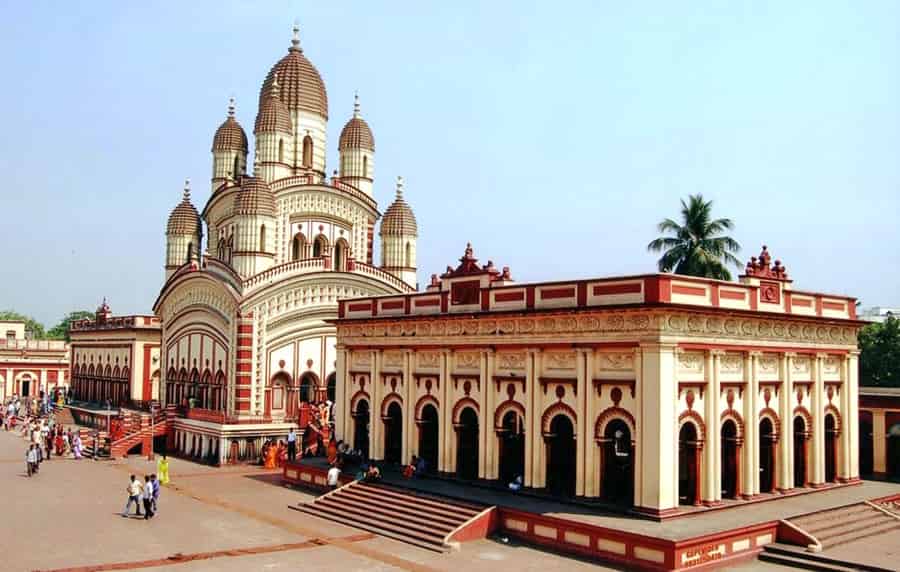
Image Credits: pilgrimagetour.in
The main temple is built in the elegant navaratna style—nine towering spires rising over 100 feet—resting on a large platform with sweeping stairs that lead devotees into Her presence. In the sanctum, Ma Bhavatarini, a compassionate form of Ma Kali, stands atop Lord Shiva, both resting upon a thousand-petaled silver lotus.
Surrounding this majestic temple are twelve identical Lord Shiva temples in the traditional Aat-Chala Bengali style, and a Radha-Krishna temple, reflecting the deep syncretism of devotion that defines Bengal's sacred landscape.
Rani Rashmoni’s Divine Vision
The temple owes its origin to a profound act of surrender.
In 1847, Rani Rashmoni, a wealthy zamindar and ardent devotee, had planned a grand pilgrimage to Kashi (Varanasi) with a fleet of twenty-four boats. But the night before her departure, Ma Kali appeared to her in a dream and said:
“There is no need to go to Banaras. Install My statue in a beautiful temple on the banks of the Ganges and arrange for My worship there. I shall manifest Myself in the image and accept worship at that place.”
Awed by this divine command, Rani Rashmoni immediately cancelled her plans and acquired a 12,000-hectare plot in Dakshineswar village.
The temple complex was constructed on land naturally shaped like a kurma (tortoise)—an auspicious symbol in Tantra Sadhana—and completed over eight years (1847–1855) at a cost of ₹9 lakh, an enormous sum at the time.
A Temple Comes Alive
On May 31, 1855, the temple was consecrated during Snana Yatra, with over 100,000 Brahmins in attendance.
The first head priest was Ramkumar Chattopadhyay, whose untimely passing in 1856 led to his younger brother, Gadadhar Chattopadhyay—later known as Sri Ramakrishna Paramahamsa—assuming the role.
What followed would transform Dakshineswar from a regional shrine into a global spiritual epicenter.
As Ramakrishna entered states of divine ecstasy and deep communion with the Divine Mother, thousands were drawn to this sacred space—not merely to witness, but to feel the living presence of Ma Kali.
Kalighat Temple: The Ancient Shakti Peetha
The Kalighat Temple in Kolkata is one of the most sacred Shakti Peethas, places where parts of Goddess Sati’s divine body are believed to have fallen as Lord Shiva wandered the universe in grief.
At Kalighat, it is said that Goddess Sati’s right toe fell, infusing the land with immense Shakti (divine feminine energy). The very name “Kalighat” comes from “Kali-Ghat”—the steps or banks of Ma Kali—referring to its original location along the Adi Ganga river.
The Unique Form of Ma Kali
Unlike traditional depictions, the idol of Ma Kali at Kalighat is distinctive and deeply symbolic. Crafted from touchstone (Kashti Pathar) around 1570 CE by the saints Brahmananda Giri and Atmaram Giri, the image features:
- Three large eyes, symbolizing Her all-seeing power
- Four golden hands, representing protection and blessings
- A long, golden tongue—extended in symbolic humility and fierce energy
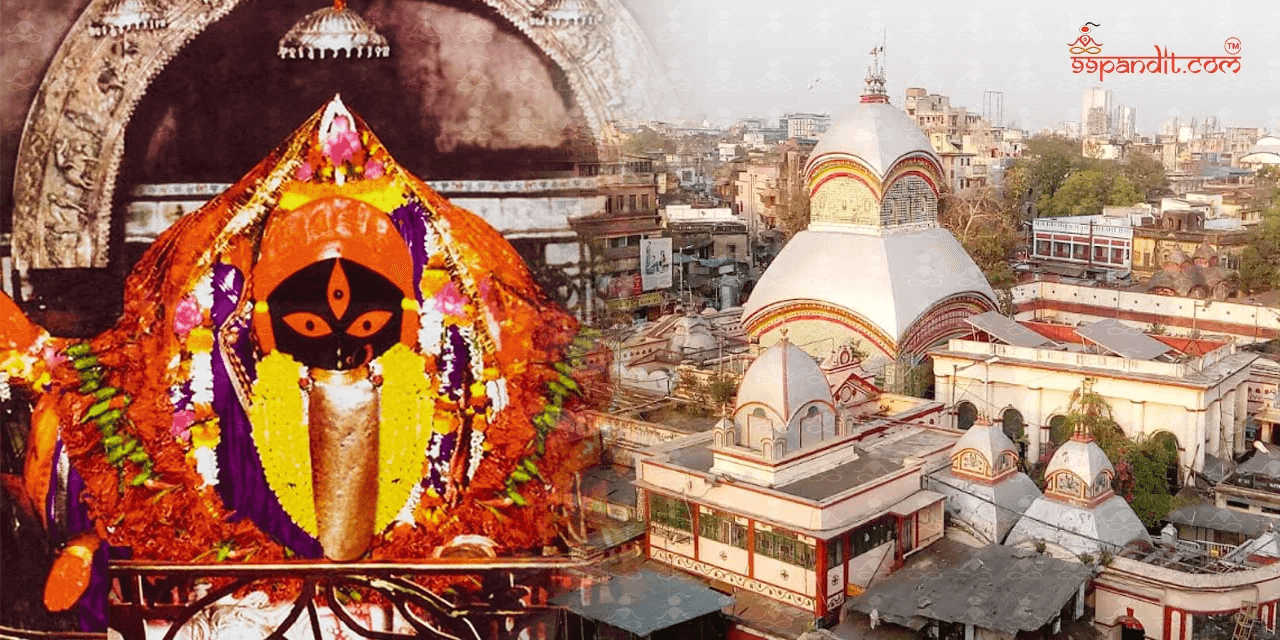
This form of the Goddess is believed to be inspired by Mata Bhuvaneshwari, the family deity of the Sabarna Roy Choudhury family, who later became principal patrons of the temple.
A Temple Rooted in Spiritual and Cultural History
Kalighat's significance is not just mythological but also historical.
For centuries, traders and pilgrims would stop here to seek Ma Kali’s blessings before continuing their journeys.
This steady stream of devotion contributed to Kolkata’s rise as both a commercial and spiritual hub, making Kalighat not just a temple, but a vital part of the city's soul.
Kamakhya Temple: The Supreme Shakti Peetha
Among all sacred sites dedicated to Ma Kali and the Divine Feminine, Kamakhya Temple in Guwahati, Assam, stands as the most revered and powerful Shakti Peetha.
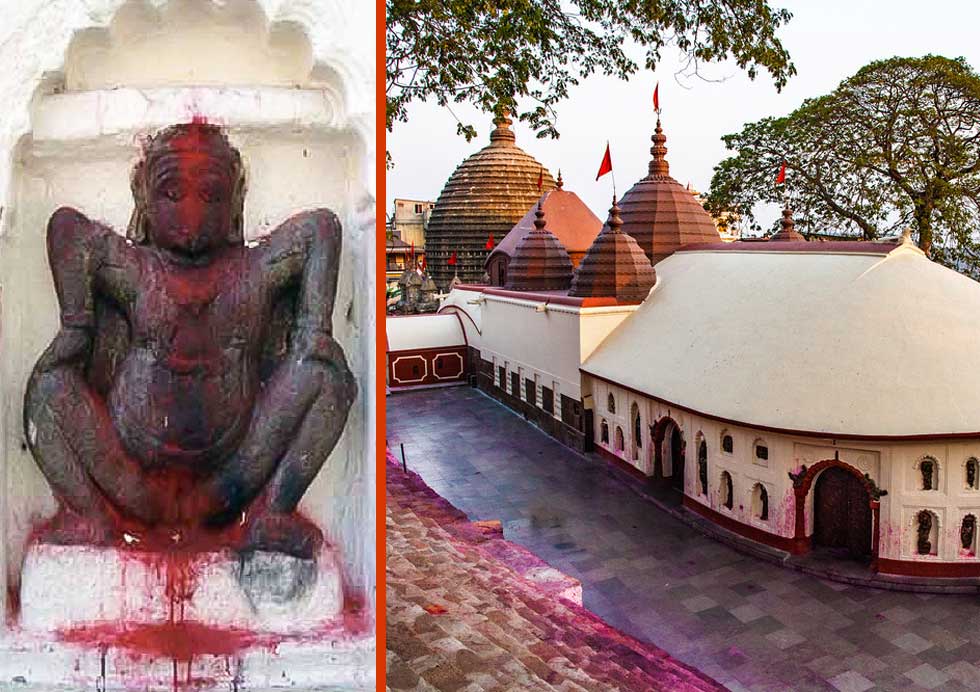
Perched atop Nilachal Hill, this temple is not only a center of fierce devotion but also a spiritual nucleus for seekers of tantric knowledge, Shakti worshippers, and pilgrims drawn to the mysteries of the Divine Mother.
Dating back to the 8th and 9th centuries, the temple's ancient stone architecture and energy-rich surroundings have made it a timeless beacon of Goddess worship.
The Kamakhya complex is surrounded by individual shrines dedicated to each of the ten Mahavidyas—the ten fierce and compassionate aspects of the Divine Feminine—including Ma Kali, Ma Tara, Ma Bhuvaneshwari, Ma Shodashi, and others, making it a rare site that unites the full power of the Mahavidya tradition in one sacred space.
Womb of the Divine Mother
What makes Kamakhya Temple truly unique is that there is no idol of Ma Kali or Ma Kamakhya in the traditional sense. Instead, devotees worship a naturally formed rock crevice shaped like a yoni—symbolizing the womb of the Divine Mother.
Water constantly flows through this sacred space, reinforcing its association with fertility, creation, and the regenerative force of Shakti.
Ambubachi Mela: The Sacred Menstruation of the Goddess
Each year, during the Ambubachi Mela, the temple closes for three days to mark Ma Kamakhya’s annual menstruation cycle—a celebration of Her fertile power and the life-giving force of the feminine.
No rituals are performed during this time, as the Goddess is believed to be resting. On the fourth day, the temple reopens with immense joy and fervor.
This four-day festival draws hundreds of thousands of devotees and Tantric practitioners from across India and beyond, all gathered in reverence for Ma’s sacred creative energy.
The Ambubachi Mela serves as a rare public acknowledgment of the spiritual sanctity of menstruation, which is traditionally hidden or taboo—making this temple not only sacred but radically empowering for feminine worship.
Tarapith: The Sacred Ground of Bamakhepa
Nestled in the Birbhum district of West Bengal, Tarapith is not only a revered Shakti temple dedicated to Ma Tara, one of the ten Mahavidyas, but also a potent spiritual epicenter of Tantric worship and divine communion.
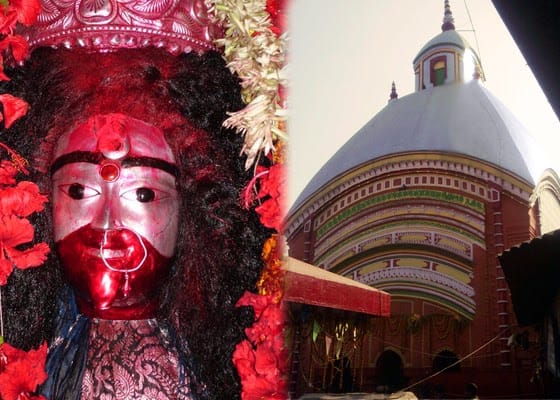
Though primarily associated with Ma Tara, her fierce form is intimately connected to Ma Kali, and the temple remains a crucial pilgrimage site for those drawn to the transformative and fearless embrace of the Divine Mother.
Cremation Ground as Sacred Space
Unlike most temples, Tarapith is located within an active cremation ground (Shmashana)—a deeply symbolic and spiritually charged site in Tantra.
Here, the Goddess is worshipped not merely in Her nurturing form, but as the liberator of fear, ego, and illusion, guiding devotees through darkness to transcendence.
The cremation ground, symbolic of death and rebirth, makes Tarapith an ideal space for Shav Sadhana—a powerful Tantric ritual in which the aspirant meditates upon the Goddess seated on a corpse, confronting mortality to attain spiritual liberation.
Bamakhepa: The Mad Saint of Ma Tara
The sanctity and fame of Tarapith grew exponentially due to the presence of Bamakhepa, the enigmatic 19th-century Tantric saint, mystic, and lover of Ma Tara. Known as the "mad saint", Bamakhepa defied social conventions, living in the cremation grounds and dedicating his life entirely to Ma.
His devotion was ecstatic, unorthodox, and intensely personal—often breaking the rules of formal temple ritual to commune directly with the Goddess.
Legend holds that Ma Tara would literally eat from his hand and appear to him in physical form, offering guidance, love, and boons.
His teachings emphasized direct experience over orthodoxy, encouraging seekers to pursue truth without fear or attachment to societal norms.
Today, the Samadhi (tomb) of Bamakhepa beside the temple draws countless pilgrims seeking spiritual blessings, inner freedom, and liberation from worldly bondage.
Shav Sadhana: The Most Esoteric Tantric Practice
Among the most secretive and spiritually charged rituals in the Tantric tradition, Shav Sadhana stands as the pinnacle of inner courage, detachment, and transcendental realization.
This ancient practice—where a sadhak meditates upon a corpse (Shava) in a cremation ground—is not an act of morbidity, but a fearless confrontation with the great illusion of death.
It is through this direct encounter with impermanence that the practitioner seeks to pierce the veil of Maya and awaken into eternal truth.
Why a Corpse? The Symbolism of Shava
In Tantric cosmology, the corpse is not seen as impure, but rather as a gateway to the formless. It represents the finality of the ego, the collapse of identity, and the raw truth that underlies all existence.
The corpse becomes the Asana (seat) for the Goddess—not because it is lifeless, but because it mirrors the silence of the Absolute.
According to esoteric teachings, the Shava is consecrated as Bhairava, the fierce and protective form of Lord Shiva, and simultaneously becomes the seat of Ma Kali or Ma Tara—who arises from the void to dissolve the practitioner’s fear, attachment, and illusion.
The Ritual Landscape
Shav Sadhana is typically performed on Amavasya (new moon night)—a time when the boundaries between the worlds are said to be thinnest. The ritual unfolds in cremation grounds (Shmashanas), riverbanks, or other secluded places steeped in the energy of impermanence.
The process begins with rigorous purification rites, invocation of the deity through Mantras, and strict adherence to secrecy and inner stillness.
The practitioner must maintain unwavering equanimity, meditating for hours without fear, revulsion, or distraction.
The presence of the corpse is not meant to induce horror but to catalyze the dissolution of Ahamkara (ego).
Only those who have been trained extensively under a realized Guru are permitted to undertake this sadhana, for it tests not just spiritual depth but mental and energetic stability.
Beyond Death: The Inner Alchemy
At its heart, Shav Sadhana is about liberation—from the body, the mind, and the illusion of separation.
By meditating on death, the practitioner comes to realize that what dies is not the Self, but only the form. In that moment of truth, the seeker becomes one with the Goddess, not as an idea, but as direct experience.
Those who have succeeded in this sadhana are said to attain Siddhis (spiritual powers), fearlessness, and in rare cases, liberation itself (Moksha).
But the true fruit of the practice is awakening into the formless presence of Ma—where nothing remains but Her.
Worshipping Ma Kali Using the Tantra Sadhana App
Now that you’ve journeyed through the sacred practice of Shav Sadhana and glimpsed the immense possibilities it offers, a natural question arises: Can a modern seeker truly access such an esoteric path?
How would one even begin this ancient practice—closely guarded for thousands of years? Must one physically sit on a corpse? Is it safe without formal initiation from a Guru?
These are valid, heartfelt questions.
Adapting the Eternal to the Present Age
Throughout history, Sanatana Dharma has experienced powerful turning points. And each time, remarkable sages have emerged to protect its sanctity while reshaping it to suit the needs of their time:
- Maharishi Ved Vyasa codified the Vedas in written form after centuries of oral transmission.
- Adi Shankaracharya revitalized the path by blending Advaita (non-duality) with Bhakti (devotion), challenging hollow ritualism.
- Swami Vivekananda sailed across the oceans to preach Vedanta globally, fulfilling his Guru’s command.
At the time, their efforts may have seemed radical. But over time, they proved to be acts of spiritual preservation.
Today, Om Swami, the founder of the Tantra Sadhana App, walks the same path of revival.
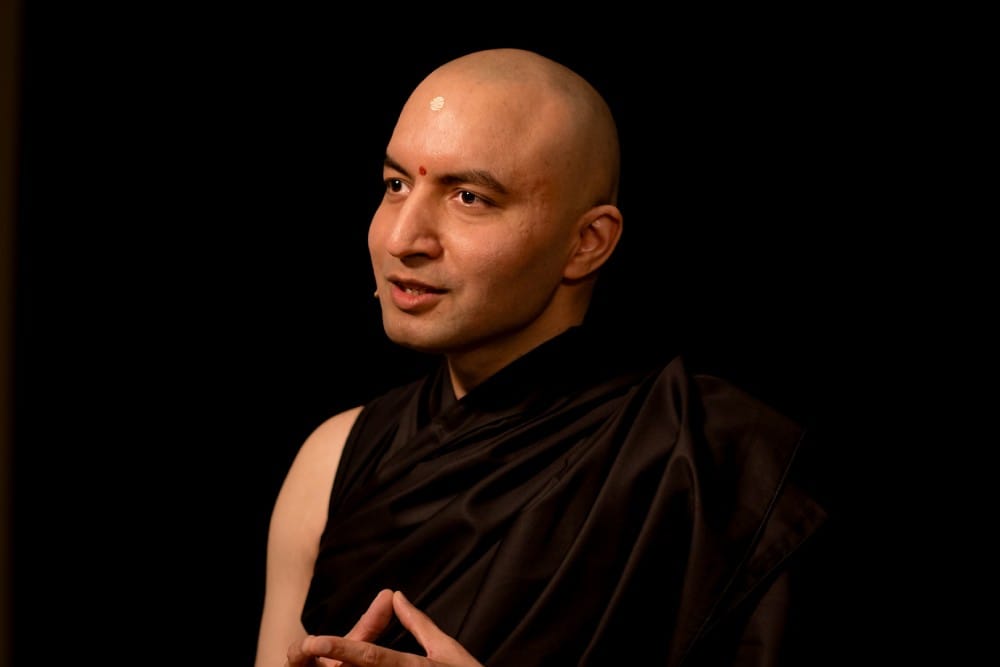
A Saint’s Birth, Foretold
Om Swami’s birth was prophesied by a saint, who gave this message to his mother, lovingly called Matarani:
“In the month of Margashirsha, when the moon is waxing, you will give birth to a special soul. One of us is coming after a very long wait—a saint.”
On 30th November 1979, during the twelfth night of the waxing moon, Om Swami was born.
By the age of eleven, he had already begun Vedic Chanting, Astrology, and performing Havans at home. He meditated in remote locations, performed Yagnas, chanted Mantras, practiced Sadhanas of many divine forms, and even undertook a Tantric Sadhana of Lord Shiva.
Alongside this intense inner journey, he mastered computer coding, founded a multi-million dollar software company in Australia, and continued his daily hours of sustained meditation.
In 2007, he renounced worldly life to pursue God-realization fully. With Matarani’s blessing, he left for the Himalayas, where years of intense Sadhana culminated in direct Darshan of Ma Devi and Lord Vishnu.
The Tantra Sadhana App: Initiation for the Modern Seeker
After returning from the Himalayas, Om Swami dedicated his life to transmitting the very Sadhanas he had once performed—so others may walk the same sacred path.
The Tantra Sadhana App is the fruit of this mission. It is a complete digital transmission system that offers awakened Tantric practices traditionally accessible only through direct initiation.
Awakened Mantras
The app contains energized Mantras of the Das Mahavidyas—the ten cosmic manifestations of the Divine Feminine, including Ma Kali, Ma Tara, Ma Bhuvaneshwari, and others. These Mantras have been personally invoked and awakened by Om Swami, enabling true energetic transmission to the seeker.
Immersive Ritual Environments
Sacred 3D spaces replicate the traditional ambiance of temples, cremation grounds, and ritual setups. These help seekers enter the correct energetic state for deep Tantric practice, bridging the gap between the digital and the divine.
Rare and Esoteric Sadhanas
Step-by-step guidance is provided for ancient practices such as:
- Shav Sadhana
- Sri Yantra Sadhana
- Khanda Munda Sadhana
- Panch Mundi Sadhana
- Advanced Tantric Homas (Fire Offerings)
These are presented without dilution, but adapted with care—so modern practitioners can approach them safely and sincerely, even without access to cremation grounds or secluded ashrams.
A Progressive Spiritual Journey
The app is structured to guide users through a spiritually tiered path—offering more advanced Sadhanas only after the practitioner has shown readiness through foundational practices.
This mirrors the ancient Guru-Shishya Parampara in spirit, while making such teachings globally accessible.
A Living Bridge Between Tradition and Technology
Just as Maharishi Vyasa, Adi Shankaracharya, and Swami Vivekananda redefined access to Dharma for their times, Om Swami’s Tantra Sadhana App ensures that even the most esoteric forms of worship—like Shav Sadhana—can be practiced with purity, guidance, and devotion, no matter where you are in the world.
It is not just an app.
It is a living temple, a spiritual transmission, and a sacred initiation—all in one.


